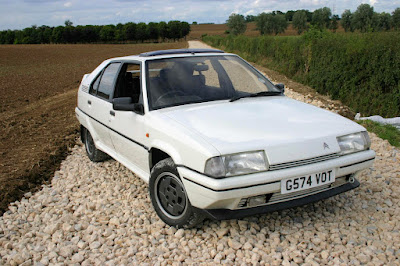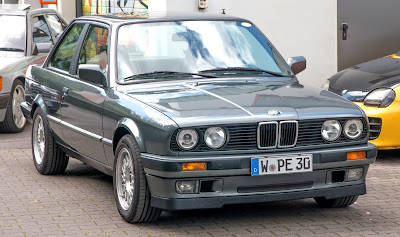Introduced September / October / November 1982
If you were looking for a classy family or small executive car in 1982, you were spoiled for choice. During the autumn of that year there were four models that came to market that helped to redefine motoring.
Ford Sierra
Cars of the 1970s and earlier tended to suffer from poor aerodynamics, being about as smooth as a brick. Best-selling models such as the Ford Cortina certainly looked the part in design terms, they had poor ergonomics and the high wind resistance contributed to poor fuel economy.
The Ford Sierra dropped the Cortina name and was utterly different to look at. A slippery design made it much more aerodynamic than its predecessor, and the liftback design gave much greater versatility than the Cortina’s saloon. Inside, the dashboard was centred around the driver, making it very much a driver’s car. Higher-end models featured advanced electronics.
 |
| Three early models of Ford Sierra |
Underneath the unconventional shell was a more conventional drivetrain using a traditional rear-wheel drive layout with some often quite elderly engines up at the front. At a time when cars in this sector were becoming front-wheel drive, it seemed a bit of a throwback.
It was a troubled car though. The “jelly mould” shape may seem more familiar today, but buyers in the early 1980s thought it went a bit too far – many still wanted a saloon rather than a liftback, and it took five years for Ford to come up with an answer to that. Conversely, the futuristic design may not have gone far enough, especially when it came to the traditional windows and rather ugly base model grille.
Sales were slow at first, but during 11 years of continuous development and product improvement, the Sierra turned into a remarkably successful car. It had a sound pedigree, with designers Uwe Bahnsen (designer of various generations of Capri, Escort, Fiesta and Cortina), Bob Lutz (BMW 3 Series, Ford Escort III) and Patrick Le Quément (Ford Cargo and later the Renault Espace, Avantime, Twingo and Megane).
The “jelly mould” certainly broke the mould of car design, although many elements look dated today. Despite being something of a design icon, the Sierra suffers from being relatively unloved. In the UK there were still a million on the road in 1995, but today it’s just a paltry 2000 or so. When was the last time you saw one in the wild?
Mercedes-Benz 190 (W201)
Like the Sierra, the Mercedes-Benz 190 was part of the so-called D Segment of cars. Unlike the Sierra, the 190 had a very different design philosophy.
It was – at the time – the smallest car ever made by Mercedes whose previous “smallest” model was the W123 luxo-barge. The 190 took all of the stylistic cues of the whole Mercedes range and subtly smoothed them out into something that could be quite understated and modern.
 |
| A trio of Mercedes-Benz 190s |
The elegant looks of the 190 were mostly down to Bruno Sacco who was responsible in part for almost every Mercedes from the 1970s to 1999. The 190 helped to create a Mercedes house style that still persists today, especially espousing the concepts of “horizontal homogeneity” (where all cars in the range share identifiable styling features) and vertical affinity (where the design is not rendered obsolete or out-of-date by its successors). This meant that the 190 and the cars that followed were all immediately identifiable as Mercedes, but none ever looked old-fashioned.
A huge range of models followed, from reliable executive cruisers that could eat up the motorway miles to complete turbonutterbastard models powered by a Cosworth engine. Despite the more traditional design than the Sierra, the 190 was about as efficient when it came to aerodynamics.
The 190 is a car that aged very well. In not trying too hard to be fashionable, it still looks quite contemporary. Like the Sierra, it had an 11-year production run – but although it was quite an uncommon car at the time, there are now more 190s – around 2900 – on the road than Sierras..
Citroën BX
The Sierra broke new ground in design, the 190 modernised the traditional… but those weren’t the only options. French manufacturer Citroën always had an eye for quirky, non-traditional designs and the BX was certainly one of those. All straight lines and radical angles, the BX appealed to those who wanted something different.
As with the other cars, the BX had a legendary designer – in this case Marcello Gandini who designed high-end cars for Lamborghini, Maserati, De Tomaso, Alfa Romeo, Iso, Lancia and more affordable vehicles for Fiat and the timeless Renault 5 Supercinq. In this case, the BX was directly influenced by two prototype designs, the Reliant FW11 and the Volvo Tundra.
 |
| Late model 16V Citroën BX |
A very lightweight design with a large number of plastic body panels, the BX had a drag coefficient even lower that the Sierra and standard 190 models. A high variety of engines filled out the range, including a Group B rally car. More mundanely, the BX was a popular estate car. And unlike the other cars mentioned here, the BX was a modern front-wheel drive layout.
The BX logically fitted in a range below the shark-like CX and above the AX supermini. This classic range of Citroën cars only coexisted for 3 years in the later 1980s, after which Citroën slow slipped into more boring designs. However, today the BX still looks fresh and doesn’t seem to have dated as much as competitors from the same era. However, it hasn’t survived well and there are just a few hundred examples on British roads today.
BMW 3 Series (E30)
The BMW 3-Series had been around for a generation by 1982, but the second-generation E30 is quite possibly the quintessential 3-Series design. A smoothed-off version of the previous E21, the E30 was sleeker and more elegant while retaining a timeless BMW design. Of all the cars mentioned here, the E30’s understated looks probably make it the most modern of the four.
During twelve years of production, the E30 had engines ranging from the sedate and economic to the insanely fast fitted. Apparently, the E30 did also include indicators although these were seldom used.
 |
| BMW 3-Series (E30) |
Again, the pedigree of the designers was excellent, with Claus Luthe and Boyke Boyer having a hand in almost everything BMW designed during this era. Elegant both inside and outside, the E30 is one of the high points of BMW styling. Modern BMWs look rather like they have been drawn by a lunatic with a box of crayons, so it’s difficult to understand how they have fallen so far.
Out of all of them though, the E30 is the most common sight on British roads with around 3800 still registered. If in good condition, the E30 is a timelessly stylish as a good suit or a nice pair of shoes. There are around 4000 E30s still left on UK roads.
All four cars were distinctive in their own ways and influenced vehicles that came afterward. Many are highly desirable – high-end Ford Sierra Cosworths can easily cost the best part of £100,000 or more – but more mundane models also have their charms.
Do any of them really look forty years old? The Sierra perhaps has dated more than most, despite being the most futuristic looking. The BX still looks fresh and not a million miles away from some of the things on the market today. The Mercedes and BMW have aged very gracefully. Which one would you choose?
Image credits:
Wouter82 via Wikimedia Commons - CC BY-SA 4.0
Alexander Migl via Wikimedia Commons - CC BY-SA 4.0
Keith Adams via Wikimedia Commons – CC0
Johannes Maximilian via Wikimedia Commons - CC BY-SA 4.0

I would choose the Mercedes. I have a customer that bought one new and it still runs like a champ today.
ReplyDelete